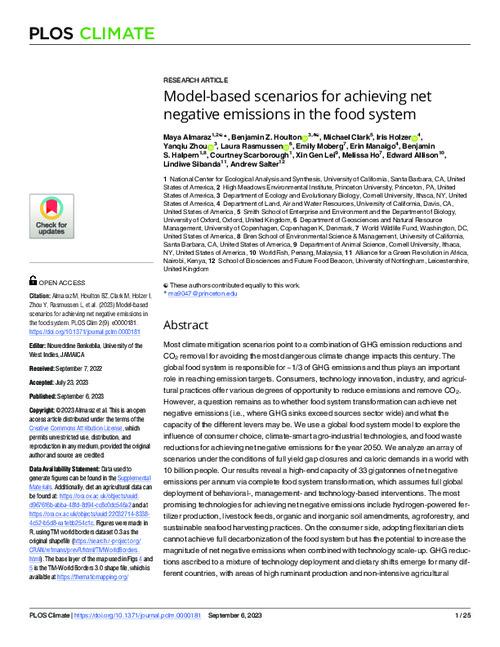Please use this identifier to cite or link to this item:
https://hdl.handle.net/20.500.12348/5759
Model-based scenarios for achieving net negative emissions in the food system
| dc.creator | Almaraz, M. | en_US |
| dc.creator | Houlton, B.Z. | en_US |
| dc.creator | Clark, M. | en_US |
| dc.creator | Holzer, I. | en_US |
| dc.creator | Zhou, Y. | en_US |
| dc.creator | Vang, L. | en_US |
| dc.creator | Moberg, E. | en_US |
| dc.creator | Manaigo, E. | en_US |
| dc.creator | Halpern, B.S. | en_US |
| dc.creator | Scarborough, C. | en_US |
| dc.creator | Lei, X.G. | en_US |
| dc.creator | Ho, M. | en_US |
| dc.creator | Allison, E. | en_US |
| dc.creator | Sibanda, L. | en_US |
| dc.creator | Salter, A. | en_US |
| dc.date.accessioned | 2024-01-14T13:51:28Z | |
| dc.date.available | 2024-01-14T13:51:28Z | |
| dc.date.issued | 2023 | en_US |
| dc.identifier.citation | Maya Almaraz, Benjamin Houlton, Michael Clark, Iris Holzer, Yanqiu Zhou, Laura Vang, Emily Moberg, Erin Manaigo, Benjamin Halpern, Courtney Scarborough, Xin Lei, Melissa Ho, Edward (Eddie) Allison, Lindiwe Majele Sibanda, Andrew Salter. (6/9/2023). Model-based scenarios for achieving net negative emissions in the food system. PLOS Climate. | en_US |
| dc.identifier.issn | 2767-3200 | en_US |
| dc.identifier.uri | https://hdl.handle.net/20.500.12348/5759 | |
| dc.description.abstract | Most climate mitigation scenarios point to a combination of GHG emission reductions and CO2 removal for avoiding the most dangerous climate change impacts this century. The global food system is responsible for ~1/3 of GHG emissions and thus plays an important role in reaching emission targets. Consumers, technology innovation, industry, and agricultural practices offer various degrees of opportunity to reduce emissions and remove CO2. However, a question remains as to whether food system transformation can achieve net negative emissions (i.e., where GHG sinks exceed sources sector wide) and what the capacity of the different levers may be. We use a global food system model to explore the influence of consumer choice, climate-smart agro-industrial technologies, and food waste reductions for achieving net negative emissions for the year 2050. We analyze an array of scenarios under the conditions of full yield gap closures and caloric demands in a world with 10 billion people. Our results reveal a high-end capacity of 33 gigatonnes of net negative emissions per annum via complete food system transformation, which assumes full global deployment of behavioral-, management- and technology-based interventions. The most promising technologies for achieving net negative emissions include hydrogen-powered fertilizer production, livestock feeds, organic and inorganic soil amendments, agroforestry, and sustainable seafood harvesting practices. On the consumer side, adopting flexitarian diets cannot achieve full decarbonization of the food system but has the potential to increase the magnitude of net negative emissions when combined with technology scale-up. GHG reductions ascribed to a mixture of technology deployment and dietary shifts emerge for many different countries, with areas of high ruminant production and non-intensive agricultural systems showing the greatest per capita benefits. This analysis highlights potential for future food systems to achieve net negative emissions using multifaceted “cradle-to-grave” and “land-to-sea” emission reduction strategies that embrace emerging climate-smart agro-industrial technologies. | en_US |
| dc.format | en_US | |
| dc.language | en | en_US |
| dc.publisher | Public Library of Science | en_US |
| dc.rights | CC-BY-4.0 | en_US |
| dc.source | PLOS Climate;(2023) | en_US |
| dc.subject | climate scenarios | en_US |
| dc.title | Model-based scenarios for achieving net negative emissions in the food system | en_US |
| dc.type | Journal Article | en_US |
| cg.contributor.funder | World Wildlife Fund | en_US |
| cg.contributor.funder | University of California-Santa Barbara, National Center for Ecological Analysis and Synthesis | en_US |
| cg.contributor.funder | Rockefeller Foundation | en_US |
| cg.contributor.funder | Wellcome Trust | en_US |
| cg.subject.agrovoc | models | en_US |
| cg.subject.agrovoc | food systems | en_US |
| cg.subject.agrovoc | greenhouse gas emissions | en_US |
| cg.contributor.affiliation | University of California-Davis | en_US |
| cg.contributor.affiliation | Cornell University | en_US |
| cg.contributor.affiliation | University of Oxford | en_US |
| cg.contributor.affiliation | University of Copenhagen | en_US |
| cg.contributor.affiliation | WorldFish | en_US |
| cg.contributor.affiliation | Alliance for a Green Revolution in Africa | en_US |
| cg.contributor.affiliation | World Wildlife Fund | en_US |
| cg.contributor.affiliation | University of Nottingham, School of Biosciences | en_US |
| cg.contributor.affiliation | University of California-Santa Barbara, National Center for Ecological Analysis and Synthesis | en_US |
| cg.contributor.affiliation | University of California-Santa Barbara, Bren School of Environmental Science and Management | en_US |
| cg.contributor.affiliation | Princeton University, High Meadows Environmental Institute | en_US |
| cg.identifier.status | Open access | en_US |
| cg.contribution.worldfishauthor | Allison, E. | en_US |
| cg.description.theme | Climate Change | en_US |
| dc.identifier.doi | https://dx.doi.org/10.1371/journal.pclm.0000181 | en_US |
| cg.subject.actionArea | Resilient Agrifood Systems | en_US |
| cg.subject.impactArea | Climate adaptation and mitigation | en_US |
| cg.contributor.initiative | Aquatic Foods | en_US |
Files in this item
This item appears in the following Collection(s)
-
Climate Change [204]
